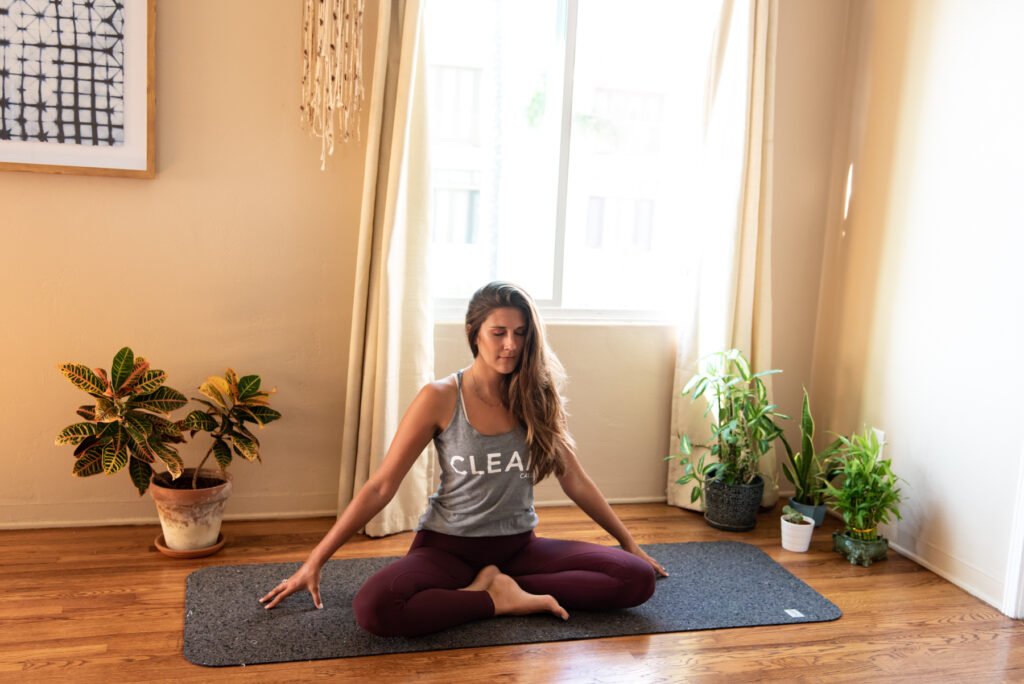Carpal tunnel syndrome is the most common entrapment neuropathy, with a prevalence in the general adult population ranging from 2.7 to 5.8 percent, according to American Family Physician. Carpal tunnel syndrome is caused by pressure on the median nerve. In this blog post, I share my favorite exercises for carpal tunnel syndrome pdf.
Anatomically speaking, the carpal tunnel is a narrow passageway surrounded by bones and ligaments on the palm side of your hand. When the median nerve is compressed, symptoms can arise including numbness, tingling, weakness and pain in the hand and arm.
Overuse, repetitive motions, and poor ergonomics are all common causes for carpal tunnel syndrome. In a recent blog post, I shared helpful tips for ergonomics and proper posture to help reduce symptoms, pain and correct alignment. In this blog post, I’ll share five simple stretches to help alleviate pain and reduce the pressure put on the median nerve.
I personally navigated really bad carpal tunnel syndrome five years ago. I had numbness, tingling, pain, weakness, and a lack of range of motion in both hands, but my right side was worse. Surgery was recommended for me on both hands. I never got surgery and healed the CTS pain on it’s own. I healed carpal tunnel syndrome on both hands with these exercises below. Now I use them regularly to prevent future pain and help my body stay in alignment.
Exercise 1: Prayer Hands for carpal tunnel syndrome
The first exercise for carpal tunnel syndrome is quite simple. You can do this one throughout the workday to help alleviate or prevent symptoms from occurring. To practice this first exercise, you can start in a seated position or standing.
Begin by finding a long spine with your shoulders rolled down away from your ears. Bring your palms together in front of your chest with your fingers spread wide. Press the pads of your fingers and pads of your palms together. Breathe steadily here. Lower your hands as much as you can while maintaining connection at the base of the palm and keeping your fingers up.
To expand this exercise, you can slowly move your hands towards the left for a few breaths then back to center before repeating on the other side. You may notice an increased stretch on the opposite side when you do this.
This exercise helps to stretch and create more space in the hand, while opening the wrist and forearm. You can try this once a day or multiple times a day.
Exercise 2: interlaced fingers
The next exercise in this series is similar to the previous one, however, you may notice you favor one versus the other, or you may find value in both. Here we are looking to create space and stretch the fingers, hands, wrists and forearm.
Begin from prayer hands (previous exercise), then interlace your fingers and press your palms away from you. Spread the fingers as best you can to create a more even stretch throughout the hand and wrist. Stay for multiple breaths, breathing slowly and steadily.
Exercise 3: wrist rolls
Wrist rolls can be done anywhere, anytime. By incorporating this movement into your daily routine, you’re helping to increase circulation to the hand and wrist, in hopes to decrease tension and tightness, and promote healing.
This ones easy: simply start with fingers spread wide as you begin to roll the wrists in one direction. I recommend moving slowly and utilizing your breath. You may notice one area or portion of the movement more than others here: pay attention! The more aware we are of our body and the sensations in our body, the more we can understand what our body needs.
You can do this at the beginning or end of the day, throughout the day, or even as a microstretch break from the desk. At the end, take a few deep breaths with the hands and fingers relaxed and notice how you feel.
Exercise 4: door stretch for carpal tunnel syndrome
Alright, this one is one for the books! Most people don’t realize that tightness and tension in the neck, upper back, and shoulder area can cause tightness, tension and restriction throughout the hand and wrist as well. This itself can lead to carpal tunnel syndrome symptoms.
Find a wall or door jam and begin in a standing position. Bring your right palm onto the wall or the door jam. Extend your arm and spread your fingers. While keeping the hand in the same position, begin to slowly move your body in the opposite direction (towards the left in this case). Ensure your right shoulder stays down and back as you breathe steadily here.
Move in the opposite direction of your hand until you feel a stretch through the hand, forearm, upper arm or chest. Take several deep breaths here. If you are looking for a deeper stretch, gently bring your left ear towards your left shoulder or slowly move your head towards the left. Be sure to listen to cues in the body as you practice this stretch.
I recommend exploring this exercise for 5-10 breaths or until you no longer feel a stretch until you switch sides. This one can be done every day or even multiple times per day depending on your needs. For more stretches to help alleviate tight shoulders and neck, check out my recent blog post.
Exercise 5: eagle arms
Eagle arms can be practices sitting down or standing up. With a long spine and shoulders down and back, bring extended arms out in front. Cross your right arm over your left arm then bend your arms. There are two options here–you can slowly wrap your hands around to your opposite shoulder (shown below) or twist the arms, bringing palms or backs of the hands together.
Align your head over the spine and take a few deep breaths. For some people, this will be enough. If you want to explore this deeper, slowly start to lift your elbows slightly up as you inhale, and lower them as you exhale.
Repeat for a few deep breaths or until you find a spot that you want to stay and stretch more deeply into. For more variations on eagle arms, join Aligned Online membership. Aligned Online is a monthly membership program that teaches you stretches and tools to reduce or overcome pain and navigate your healing journey.
Exercises for carpal tunnel syndrome PDF
Although symptoms brought on by carpal tunnel syndrome can be quite alarming, there are many easy ways to stretch, release tension and promote blood flow, circulation and proper healing to this area. I recommend trying these exercises for carpal tunnel syndrome pdf regularly, if not daily, for best results. If you have any questions for me, please don’t hesitate to reach out. I’d love to see how I can support you through answering your questions or providing yoga therapy coaching for you.
In addition to stretching regularly, there are other tips I recommend my clients to help alleviate or prevent symptoms. One of the most important things is adjusting your posture and ergonomics to support proper alignment through the neck, shoulder, arm and hand. If you want to learn more about creating better posture, I created a post on this here.
If you’re looking for more support with exercises, yoga therapy classes, and trainings specifically on carpal tunnel syndrome, and so much more, I invite you to join Aligned Online membership where you’ll find a vault of over 160 yoga classes to practice on demand with new classes to your inbox every week. Click here to learn more and join Aligned if it feels right for you!

Ready to learn yoga poses for back pain, heal chronic pain & feel your best?
Aligned Online is a monthly membership program for people that want to lead a pain free life and ditch chronic pain aches, & injuries by improving posture, building strength & mobility & managing stress through guided yoga therapy classes.

